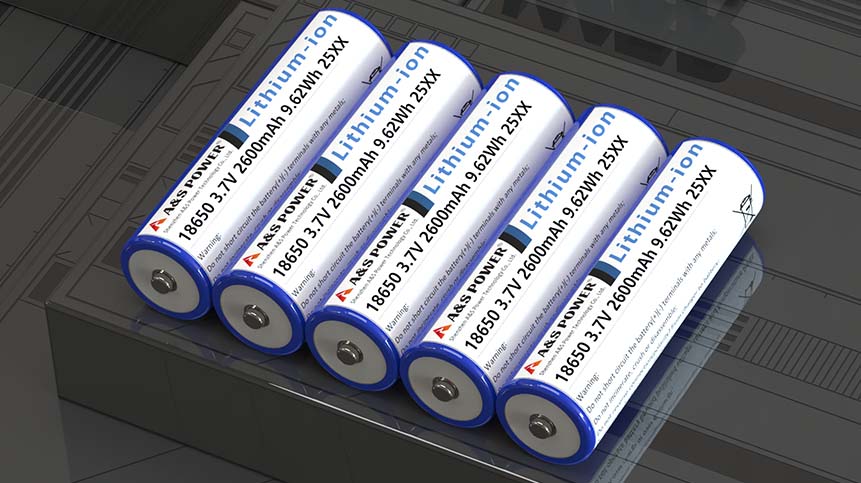Understanding 18650 Lithium-Ion Battery Cycle Life: Causes of Decay and Key Improvement Technologies
Introduction
18650 lithium-ion batteries are widely used in laptops, electric vehicles, and portable electronics due to their high energy density. However, their cycle life—how many charge and discharge cycles a battery can undergo before its capacity drops to about 80%—remains a key challenge. For instance, an 18650 cell in a laptop might last 500–1000 cycles, while EV applications require 2000+ cycles to be economically viable.
Understanding decay mechanisms and technical improvement methods is crucial for advancing battery performance and durability.
1. 18650 Lithium-Ion Battery Basics
An 18650 battery is cylindrical (18mm diameter, 65mm length) and composed of three main components:
-
Positive electrode: typically lithium cobalt oxide (LCO) or nickel-cobalt-manganese (NCM);
-
Negative electrode: high-purity graphite;
-
Electrolyte: lithium salt in organic solvents.
During charging, lithium ions move from cathode to anode and intercalate into graphite layers; during discharge, they return—this reversible movement provides energy for devices.
2. Cycle Life Decay Mechanisms
(1) Loss of Active Lithium Ions
Side reactions between electrolyte and electrodes form the solid electrolyte interphase (SEI), consuming active lithium. Each cycle can lose 0.1–0.5% of available lithium, gradually reducing capacity.
(2) Electrode Material Degradation
Positive electrodes undergo crystal structure collapse and metal ion dissolution (e.g., cobalt leaching), while graphite anodes develop cracks and thick SEI layers, increasing internal resistance and reducing charge transfer efficiency.
(3) Other Physical and Chemical Changes
Electrolyte decomposition and separator pore blockage restrict ion flow. Internal resistance rises, heat increases, and aging accelerates—a vicious thermal cycle that reduces lifespan.
3. Factors Affecting Cycle Life
(1) Charging and Discharging Conditions
Fast charging (≥1C rate) increases heat and SEI formation.
Overcharging (>4.2V) or full discharge (0V) causes irreversible damage.
Maintaining charge between 20–80% can double the cycle life.
(2) Temperature Effects
-
High temperature (45–60°C): accelerates electrolyte decomposition and ion loss.
-
Low temperature (<0°C): causes lithium plating on the anode, leading to short-circuit risks.
Example: A cell stored at 60°C may lose 20% capacity in 6 months, versus 5% at 25°C.
(3) Manufacturing Quality
Uneven coating, impure electrolyte, or inconsistent separator thickness can all shorten battery life. Premium materials and process precision are essential.
4. Technical Approaches to Improve Cycle Life
(1) Material Innovations
-
Lithium Iron Phosphate (LFP): superior structural stability and 3000+ cycle lifespan; ideal for EV and storage use.
-
Silicon-doped or coated graphite anodes: 10× higher lithium capacity, reducing SEI thickening.
-
Electrolyte additives (e.g., Vinylene Carbonate - VC): form protective SEI layers to suppress unwanted reactions.
(2) Battery Design Optimization
-
Thinner, porous ceramic separators enhance ion flow and resist thermal shrinkage.
-
Optimized electrode thickness and lightweight collectors (Al/Cu foil) minimize internal stress.
-
Gas relief valves reduce swelling and internal pressure buildup.
(3) Smart Battery Management Systems (BMS)
AI-assisted BMS monitor voltage, current, and temperature to:
-
Prevent overcharge/discharge;
-
Balance cells across packs;
-
Regulate charging rate above 40°C.
This can extend 18650 pack life from 1500 to 2500+ cycles, particularly in EV systems.
Conclusion
18650 lithium-ion battery degradation arises from ion loss, electrode fatigue, and structural changes, exacerbated by temperature extremes and poor charge control.
By integrating stable electrode materials (LFP), optimized design, and intelligent BMS, manufacturers can dramatically improve cycle life.
As research advances into solid-state electrolytes and nanostructured electrodes, the next generation of lithium batteries promises higher reliability, longer life, and safer performance—powering the future of clean energy, EVs, and advanced electronics.
-

 May.2025.11.24Ternary Lithium Battery vs Lithium-ion: Complete Comparison Guide (2025 Edition)Learn More
May.2025.11.24Ternary Lithium Battery vs Lithium-ion: Complete Comparison Guide (2025 Edition)Learn More -

 May.2025.11.214S2P 18650 14.8V Battery: Complete Technical Guide, Specs, Applications & SafetyLearn More
May.2025.11.214S2P 18650 14.8V Battery: Complete Technical Guide, Specs, Applications & SafetyLearn More -

 May.2025.11.18PCM vs BMS in Lithium Batteries: What’s the Difference and Which One Do You Need?Learn More
May.2025.11.18PCM vs BMS in Lithium Batteries: What’s the Difference and Which One Do You Need?Learn More -

 May.2025.11.17Custom Li-ion Battery Design for Medical Devices (2025 Comprehensive Guide)Learn More
May.2025.11.17Custom Li-ion Battery Design for Medical Devices (2025 Comprehensive Guide)Learn More -

 May.2025.11.17The Future of Lithium-Ion Batteries: Innovation, Sustainability, and Global Market TrendsLearn More
May.2025.11.17The Future of Lithium-Ion Batteries: Innovation, Sustainability, and Global Market TrendsLearn More
















